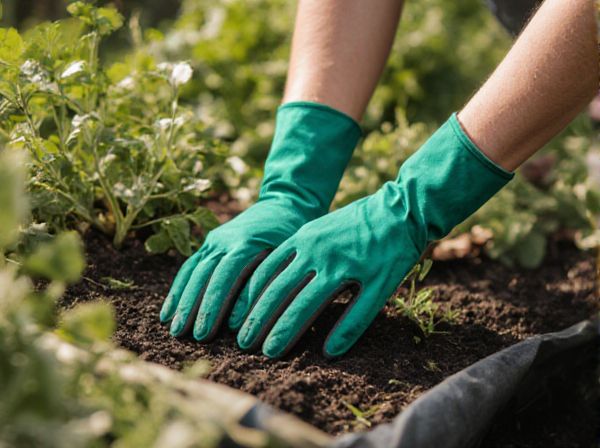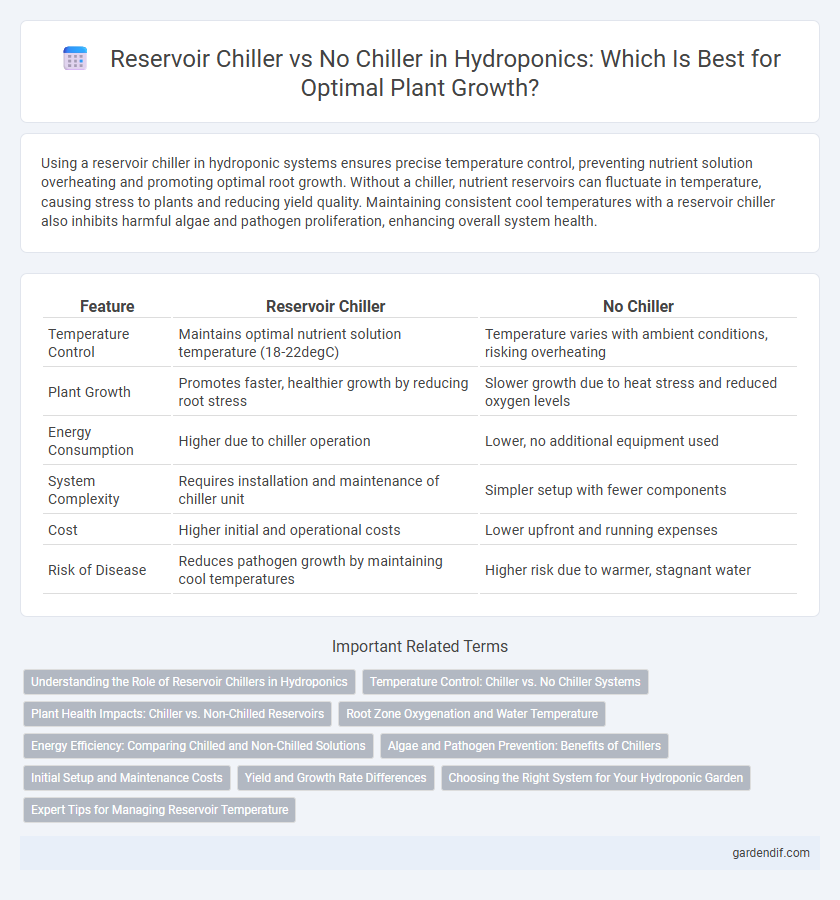
Reservoir Chiller vs No Chiller Illustration
Using a reservoir chiller in hydroponic systems ensures precise temperature control, preventing nutrient solution overheating and promoting optimal root growth. Without a chiller, nutrient reservoirs can fluctuate in temperature, causing stress to plants and reducing yield quality. Maintaining consistent cool temperatures with a reservoir chiller also inhibits harmful algae and pathogen proliferation, enhancing overall system health.
Table of Comparison
| Feature | Reservoir Chiller | No Chiller |
|---|---|---|
| Temperature Control | Maintains optimal nutrient solution temperature (18-22degC) | Temperature varies with ambient conditions, risking overheating |
| Plant Growth | Promotes faster, healthier growth by reducing root stress | Slower growth due to heat stress and reduced oxygen levels |
| Energy Consumption | Higher due to chiller operation | Lower, no additional equipment used |
| System Complexity | Requires installation and maintenance of chiller unit | Simpler setup with fewer components |
| Cost | Higher initial and operational costs | Lower upfront and running expenses |
| Risk of Disease | Reduces pathogen growth by maintaining cool temperatures | Higher risk due to warmer, stagnant water |
Understanding the Role of Reservoir Chillers in Hydroponics
Reservoir chillers maintain optimal nutrient solution temperatures between 65-75degF, preventing root stress and promoting oxygen absorption in hydroponic systems. Without a chiller, high temperatures can lead to decreased dissolved oxygen levels, encouraging harmful pathogen growth and reducing plant vigor. Utilizing a reservoir chiller enhances root health, maximizes nutrient uptake, and supports consistent crop yields in controlled environments.
Temperature Control: Chiller vs. No Chiller Systems
Reservoir chillers maintain optimal nutrient solution temperatures, preventing root stress and enhancing oxygen availability, which boosts plant growth in hydroponic systems. Without a chiller, temperatures often fluctuate, increasing the risk of overheating and pathogen development that can stunt plant health. Precise temperature control with a chiller ensures consistent root zone conditions, maximizing nutrient uptake and overall yield.
Plant Health Impacts: Chiller vs. Non-Chilled Reservoirs
Reservoir chillers maintain optimal nutrient solution temperatures between 65-72degF, preventing root zone heat stress that can lead to oxygen depletion and increased susceptibility to root diseases like pythium. Non-chilled reservoirs often experience elevated temperatures above 75degF, reducing dissolved oxygen levels and promoting pathogen growth, which negatively affect plant health and yield. Consistent cooling from reservoir chillers enhances root development, nutrient uptake, and overall crop vigor in hydroponic systems.
Root Zone Oxygenation and Water Temperature
Reservoir chillers maintain optimal water temperatures between 18-22degC, enhancing root zone oxygenation by preventing thermal stress and promoting nutrient uptake in hydroponic systems. Without a chiller, elevated water temperatures above 24degC reduce dissolved oxygen levels, leading to root hypoxia and increased susceptibility to pathogens. Efficient temperature control with a reservoir chiller stabilizes the root environment, ensuring robust plant growth and higher yields in hydroponic setups.
Energy Efficiency: Comparing Chilled and Non-Chilled Solutions
Reservoir chillers in hydroponic systems significantly enhance energy efficiency by maintaining optimal nutrient solution temperatures, reducing plant stress and improving growth rates. Non-chilled systems often experience higher energy consumption due to inconsistent temperature control, leading to increased costs and potentially lower yields. Investing in a reservoir chiller can result in long-term energy savings and better resource management within controlled environment agriculture.
Algae and Pathogen Prevention: Benefits of Chillers
Reservoir chillers effectively reduce water temperatures, creating an environment that inhibits algae growth and pathogen proliferation in hydroponic systems. Lower temperatures slow down microbial metabolism, minimizing risks of root diseases and maintaining oxygen levels optimal for plant health. Using chillers enhances system cleanliness and stability, promoting higher crop yields and quality.
Initial Setup and Maintenance Costs
Reservoir chillers significantly increase the initial setup cost of a hydroponic system due to the price of the chiller unit and necessary installation components. Ongoing maintenance expenses are also higher, as chillers require regular cleaning, coolant checks, and occasional repairs to maintain optimal performance. In contrast, systems without chillers have lower upfront and maintenance costs but risk temperature fluctuations that can affect plant growth and nutrient uptake efficiency.
Yield and Growth Rate Differences
Using a reservoir chiller in hydroponic systems significantly enhances yield and growth rates by maintaining optimal nutrient solution temperatures, typically between 65-70degF (18-21degC). Cooler nutrient solutions promote oxygen retention and root development, reducing stress and preventing pathogen proliferation compared to systems without chillers where temperatures often exceed 75degF (24degC). Studies show hydroponic setups with chilled reservoirs can boost growth rates by up to 25% and increase crop yields by 15-20% over non-chilled systems.
Choosing the Right System for Your Hydroponic Garden
Selecting the right cooling system for your hydroponic garden depends on factors such as reservoir volume, ambient temperature, and plant sensitivity to temperature fluctuations. Reservoir chillers actively maintain optimal water temperatures by dissipating heat, preventing root stress and promoting nutrient uptake, while systems without chillers rely on passive cooling methods that may be insufficient in warmer climates. Investing in a reservoir chiller ensures consistent temperature control, which enhances plant growth, reduces disease risk, and maximizes yield efficiency.
Expert Tips for Managing Reservoir Temperature
Maintaining an optimal reservoir temperature between 18-22degC significantly enhances nutrient uptake and root oxygenation in hydroponic systems. Experts recommend using a reservoir chiller to consistently regulate temperature, preventing heat stress and pathogen growth that commonly occur without chilling devices. For those without chillers, strategies like insulating reservoirs, increasing airflow, and frequent water changes help mitigate temperature spikes and maintain a stable root environment.
Reservoir Chiller vs No Chiller Infographic

 gardendif.com
gardendif.com